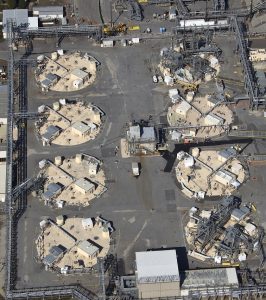
“Annual Radioactive Waste Tank Inspection Program – 2018,” June 2019
“Rainwater continues periodically to be observed migrating into the annuli of some tanks. Evidence of this infiltration was primarily noted by observation of surface stains, and occasionally by calciferous deposits, changed configuration of salt deposits in the associated annulus, and mild surface corrosion. The conditions of the 43 tanks remained essentially unchanged from the conditions reported in 2017. The one key exception was the identification of eight new cracks in the Tank 15 primary tank wall. These newly identified cracks are located at 65, 67, 70, 76, 150, 152, 176 inches and 200 inches above the tank bottom. The identified cracks in Tank 15 do not constitute an impact on the structural integrity of the tank, as evaluated and confirmed in the referenced report, SRNS‐STI‐2008‐00028, A Structural Impact Assessment of Flaws Detected During Ultrasonic Examination of Tank 15, and calculation, T‐CLC‐H‐00890, Calculation of Critical Crack Lengths in HLW Tank 15. The 2018 inspection program confirmed the structural integrity and waste confinement capability of all 43 waste tanks.”
>>> document linked here: https://adamswebsearch2.nrc.gov/webSearch2/main.jsp?AccessionNumber=ML19318F625
And, two documents on groundwater contamination and monitoring:
“Scoping Summary for the General Separations Area Western Groundwater Operable Unit (U),” September 2018
“SRS characterized the nature and extent of GW contamination. The primary GW contaminants are volatile organic compounds (VOCs), radionuclides, and nitrate. Tritium, iodine-129, and trichloroethylene (TCE) are sporadically above MCLs in GW at points of discharge at the seeplines. However, concentrations in adjacent surface water are consistently below MCLs.” [maximum contaminant limits]
>>> document inked here: https://adamswebsearch2.nrc.gov/webSearch2/main.jsp?AccessionNumber=ML19318F969
“Scoping Summary for the General Separations Area Eastern Groundwater Operable Unit (U),” September 2018
“Tritium has been detected in the GW of the GSA Eastern GW OU since monitoring began in 2002. In 2017, the maximum tritium concentration was 28.9 pCi/mL at well HGW 2D as shown on Figure 2. This well has a history of tritium slightly above the MCL and has remained stable over the past several years.”
“In 2017, gross alpha was detected in three wells (HAA 12A, HAA 15A, and HCB 2) above the screening level of 15 pCi/L. At well HCB 2, the gross alpha concentration was 17.3 pCi/L. Although elevated above the screening level in 2017, the latest result in 2018 was below the screening level at 8 J pCi/L. SRS believes wells HAA 12A and HAA 15A are not providing samples representative of aquifer conditions due to grout intrusion. Gross alpha was below 15 pCi/L in all other wells in 2017.”
>>> document linked here: https://adamswebsearch2.nrc.gov/webSearch2/main.jsp?AccessionNumber=ML19318F625